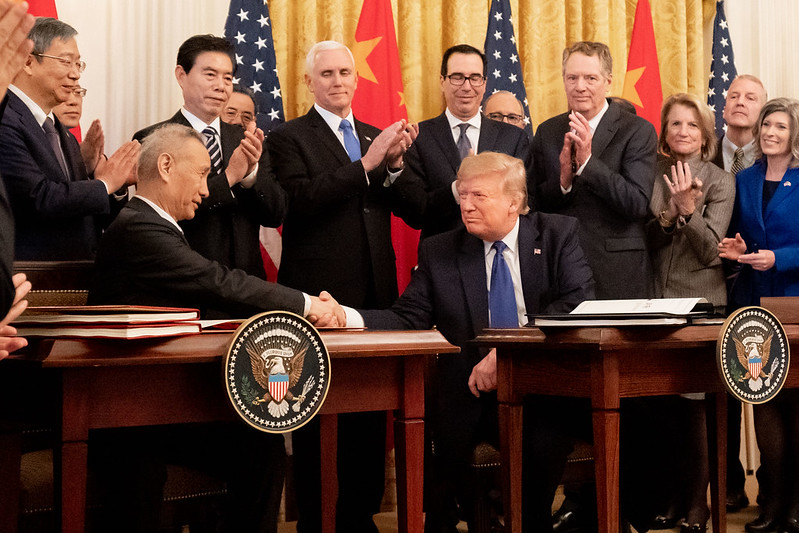
A new report from the U.S. Trade Representative finds China’s government hasn’t done enough when it comes to intellectual property protection and enforcement.
It’s sort of a mind trip to think about what the world was like back in January 2020, before COVID-19 shut so much of it down.
But think back, to the before times. To the long, long ago. One of the biggest stories back in January 2020 was the signing of the “Phase 1” trade agreement between the United States and China.
It was supposed to be the first step in the Trump administration’s grand effort to reshape the uneven trade relationship between the two countries. Then-President Donald Trump even had a whole fancy event at the White House for the signing.
Only the deal… wasn’t that great.
Alliance for American Manufacturing President Scott Paul dubbed it “completely inadequate” at the time, pointing out it failed to address some of the biggest trade issues, including China’s government subsidies, state-owned enterprises, state-sponsored industrial overcapacity, predatory investments, and a slew of other labor and environmental misdeeds.
Instead, the U.S. agreed to drop some tariffs in exchange for China pledging to buy $200 billion more in American products and services over two years. China also agreed to refrain from currency devaluation, approve market access for American companies, and strengthen intellectual property (IP) protection and enforcement.
We’ve already known China is falling behind on its pledge to buy American products, and things don’t appear to be going great on currency, either. While the Treasury Department declined to name China as a currency manipulator in the latest exchange policy report a couple weeks ago, it made a point to urge China to “ improve transparency regarding its foreign exchange intervention activities, the policy objectives of its exchange rate management regime, the relationship between the central bank and foreign exchange activities of the state-owned banks, and its activities in the offshore RMB market.”
And now a new report from the U.S. Trade Representative (USTR) finds that China isn’t keeping its “Phase 1” commitments when it comes to IP protection. Take it away, Lando!

The USTR unveiled its Annual Special 301 Report on Intellectual Property Protection report last week, in which it examined the “adequacy and effectiveness of U.S. trading partners’ protection and enforcement of intellectual property rights.”
USTR examined more than 100 trading partners for the report and ended up naming nine countries to the agency’s “Priority Watch List,” which were those nations that presented “the most significant concerns this year regarding insufficient IP protection or enforcement or actions that otherwise limited market access for persons relying on intellectual property protection.”
China was named to the list, along with Argentina, Chile, India, Indonesia, Russia, Saudi Arabia, Ukraine, and Venezuela.
And while the USTR made a point of noting that China published “a large number of draft IP-related legal regulatory measures and finalized over a dozen measures” over the past year, those efforts fall far short of what’s needed. According to the report:
“China needs to deepen reforms strengthening intellectual property (IP) protection and enforcement, fully implement recent revisions to its IP measures, refrain from requiring or pressuring technology transfer to Chinese companies, open China’s market to foreign investment, and allow the market a decisive role in allocating resources.”
Specifically, the USTR notes that the theft of trade secrets remains a big concern, as does bad faith trademarks, counterfeit goods (including online), copyright law, and patent examinations. Technology transfers also remain a major issue, as Chinese officials “have made high-level statements suggesting that IP rights should be linked to national security and the ‘external transfer’ of IP rights in certain technologies should be prevented.”
So, to recap:
- China pledged to buy a whole lot more U.S. products and services. It has not met those goals.
- China promised not to manipulate its currency. There’s a whole lot more work to do there.
- China said it would get serious about IP protection and enforcement. That’s not happening in any meaningful way.
The Phase 1 deal wasn’t all that great to begin with. It let China’s government off the hook for some of its most egregious unfair trade practices.
And yet China won’t even meet the basic pledges that were in the deal.
The Biden administration didn’t negotiate the “Phase 1” deal. It was a bad deal. But as U.S. Trade Representative Katherine Tai noted during her confirmation hearing, it is the agreement that is now on the books with China. The administration must take necessary steps to see that the commitments China made are enforced.
And as Team Biden looks to shape its own policy on China, it should remember how China’s government repeatedly broke the straightforward promises it made 16 months ago.
